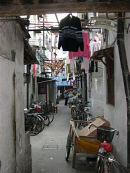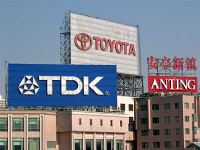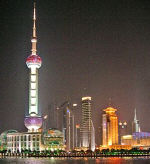One Foot in the Future
Shanghai, China
There’s an ancient Chinese proverb that says “A journey of a thousand miles must begin with a single step.” When we decided to venture to Shanghai for the Chinese New Year, we learned quickly that in doing so you tread a well-worn track that marks a long and difficult path to prosperity for this Asian mega-city.
Shanghai is an enigmatic city filled with modern contradictions still struggling to come to terms with its turbulent history. It’s New China – where an Imperial past wrestles with the Communist present and a neo-Capitalist future. It’s an intoxicating fusion of old and new and a bold vision of what may be to come.
It’s is also the largest city in China, home to just over 12 million people – though, as we were constantly reminded on our trip: Shanghai is not China, it’s Shanghai. Gateway to the mighty Yangtze River, Shanghai has a tragic and tumultuous past – a sad legacy of exploitation that in many ways it may be doomed to repeat.
Up until the mid-1800s, Shanghai was little more than a small fishing town (in fact the name Shanghai just means ‘on the sea’ in Chinese). Then, overnight, everything changed. Sensing a lucrative new market in China, the British East India Company began shipping thousands of tons of Indian-grown opium into China in return for tea. Much of this trade naturally went through large ports like Shanghai.
Eventually war broke out when, in November 1839, in an effort to deal with the opium problem, Chinese authorities sealed their ports and Chinese junks attempted to prevent the English merchant vessels from trading. In true Imperial style, the Brits retaliated by sending in its fleet of warships and smashing the Chinese blockade. No match for the technological superiority of the British forces, the Chinese were eventually forced to agree to a shameful surrender under the Treaty of Nanking.
The treaty gave the British possession of five open ports in China, the most significant being Shanghai. And like frenzied sharks honing in on an injured fish, the other Imperial powers moved in shortly thereafter. The French were next (in 1847), followed in quick succession by the Americans and the Italians. Everyone wanted in on the action.
So, through the first few decades of the 20th Century, the world landed on Shanghai’s doorstep. The city was parceled up into administrative districts and each subsequently took on the distinctive character of its Imperial master. The French Concession aped Old World architecture and created leafy boulevards and cafes that wouldn’t be out of place in any European capital. The Brits built magnificent, soaring marble edifices along the Bund as the bankers and financiers moved in, eventually making Shanghai the most important commercial centre in the Orient.
All seemed perfect. For a while anyway…
New Year’s Eve, and the Year of the Monkey was nearly upon us. The air was frosty as we stepped out of the subway station and tentatively onto Nanjing Road, Shanghai’s famous pedestrian mall. Once renowned for “ten miles of foreign glamour,” Nanjing Road is still the most prosperous commercial street in China. Neon abounds as large department stores jostle with niche boutiques in cutthroat competition for passing shoppers’ attention.


Frigid temperatures meant meat and laundry hung outside together
![]()
![]()
As we worked our way through the crowds of shoppers, arctic winds whipped through the side narrow streets, stirring up miniature cyclones in the intersections. It was so cold that unbelievably, along with drying laundry, people had hung out their meat to refrigerate on their clotheslines.
Marching steadily, heads down to get the better of the bitter cold, we were stopped abruptly in our tracks by an awesome pyrotechnic battle that erupted before us. Shopkeepers unrolled gigantic rolls of firecrackers into the street. Oblivious to traffic and passersby, they ignited one end and scurried to safety as a concussive series of fiery blasts rang out across the street.
It’s not really surprising that the Chinese, given they did invent gunpowder, have a serious penchant for fireworks. Each shopkeeper tried their best to outdo the other. They brought out enormous mortar shells that would launch 50 or 60 feet into the air before detonating in a massive blast and showering the street with confetti. By the end of the battle, the acrid stench of gunpowder filled the air and smoke hung still in the streets, stinging our eyes.
The barrage continued for the rest of the evening. The dull roar of explosives rang throughout the city and it was as if we were wandering the war torn streets of Beirut or Kabul rather than this Asian metropolis. As if on cue, at midnight, the Jetson-esque cityscape of Pudong across the river lit up like CNN footage of Baghdad in an air raid.
Traditionally, the Chinese believe that the lighting of fireworks scares away evil demons and ensures good luck and fortune for the New Year. But perhaps what people should be trying to ward off today are not winged monsters, but rather the culture crushing hydra of Western consumerism.
It was the Communists who eventually killed Imperial Shanghai. After suffering the very worst at the hands of the Western imperialists, it’s no surprise then really to learn that the Communist Party of China was born in Shanghai in 1921.
It wasn’t until May 1949 however, that the Communist forces under Mao Zedong were finally able to seize control of Shanghai. Eventually all the old factories, abandoned by the departing imperial powers, were nationalized under the red flag in 1953.
Then, in 1990, Shanghai was declared a special economic zone by the Chinese government and in the years that followed, billions of dollars of foreign investment poured in as multi-national corporations from around the world rushed to stake out their claim in the fastest growing market in the world.
Sound eerily familiar?
Today, Shanghai has been transformed, reborn once again as a center of international trade and finance. Only this time, the foreign occupiers don’t come flying national colors – this time it is the Golden Arches and the United Colors of Benetton.


Close-up of the massive billboards that dot the city
![]()
![]()
After the bedlam the night before, we sat quietly enjoying a cup of coffee in a Starbucks Coffee shop. Western consumerism has arrived with vigor in Shanghai and it’s not just the gargantuan billboards that clutter every inch of the skyline or the giant video screens in the subways or even the McDonald’s or KFC outlets that seem to cluster on every other city block. Rather, it’s the fact that it seems that everything in this city seems to be geared towards one goal… shopping. I think the late Chinese leader Deng Xiaoping sums up Shanghai’s attitude best when he famously said, “To get rich is glorious.”
The French Concession once embodied the height of European decadence. Now, Huaihai Road, formerly Avenue Joffre, looks more like Rodeo Drive and includes the obligatory pantheon of brands found in any modern metropolitan setting. Any sign of Shanghai’s Communist past has all but been relegated to quaintly named parks like ‘People’s Square’ and the ‘Monument to the People’s Heroes.’
So, shop we did. Over the course of our stay in this “Shopper’s Paradise”, we hit every market in the city – from the schmaltzy knock-off markets full of North Face jackets, Rolex watches and bootleg DVDs, to the more subdued bird market where most of the animals had been moved out of the city due to SARS concerns.
We visited a shooting range, just off of the main shopping drag, where you can walk in right off the street and fire Chinese assault weapons. Right next door was a spa where afterwards we relaxed with neck and back massages. Apparently even in an emerging economy you need to balance guns and butter.
When we were not shopping, we rode through the Bund tourist tunnel on a wildly lit, lazy-paced tram ride that was remindful of the scene in 2001: A Space Odyssey when Bowman approaches the surface of Monolith. Only more boring.
We journeyed to the top of the Oriental Pearl Tower, a massive phallic tusk that thrusts up into the Pudong skyline. While its height provided lots of magnificent viewpoints, mostly it just proved to be another exercise in another of the more popular Chinese pastimes – queuing up.
We spent a lot of time just wandering about the city marveling at its architecture which ranges from classically magnificent to space-age kooky. Surprisingly little, if any, bore any Chinese influence and it was easy to forget you were even in Asia.


A night view of the futuristic Pudong cityscape
![]()
![]()
Despite this, walking the vibrant streets of Shanghai, you can’t help but get the feeling the Chinese dragon is slowly emerging up from its slumber. It’s shaking off its Imperial past, brushing aside its Communist trappings and reaching out towards an unknown future.
But if Shanghai’s to dominate the 21st Century, as it did much of the first half of the 20th Century, it will need to remain resolute even in the face of the multi-national corporate land grab that it is enjoying today. From its precarious position, it’s going to look hard for its own identity if it’s to avoid the sharks that are encircling it once again.
Staring out of my tiny oval window as our plane raced into the skies, I looked down at a spaghettied maze of superhighways crisscrossing the land around Shanghai and, much to my surprise, realized that they were completely empty.
I can only hope that when that dragon finally does wake up and those Shanghai roads are full, this time it will be the Chinese in the driver’s seat.
——–